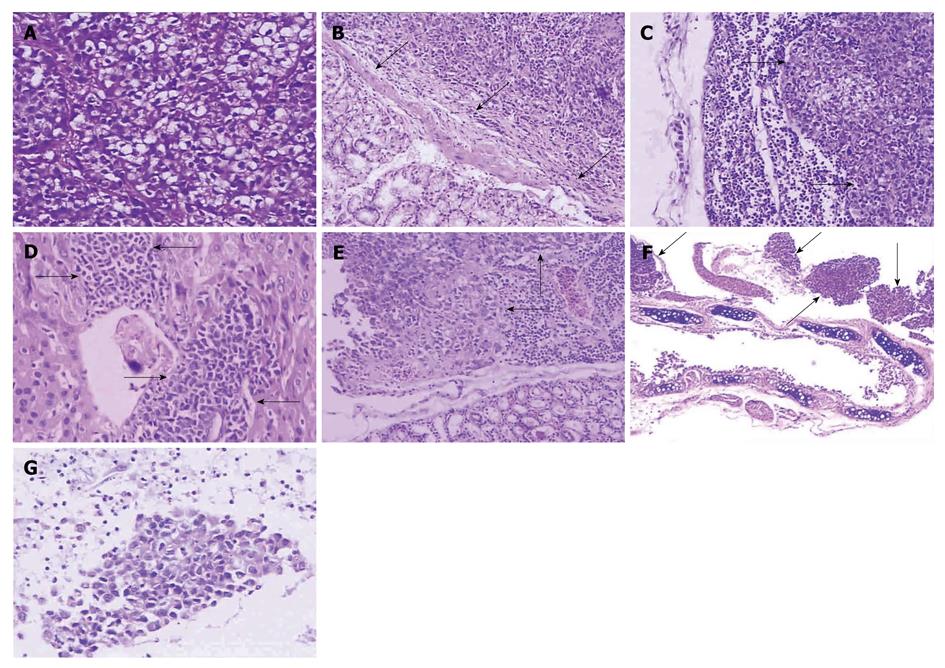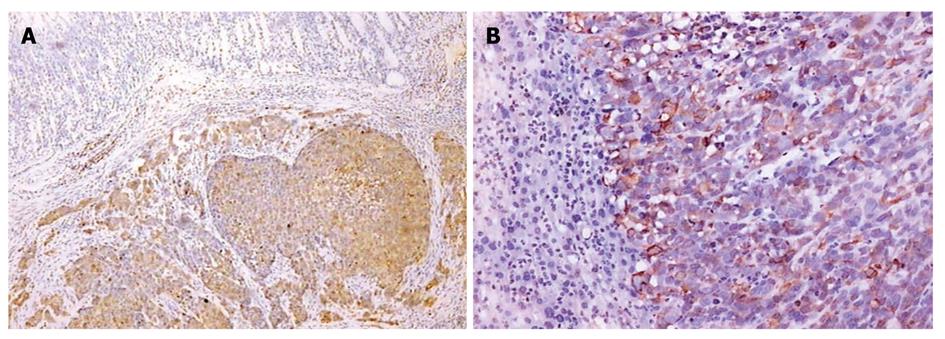Copyright
©2011 Baishideng Publishing Group Co.
World J Gastroenterol. Mar 21, 2011; 17(11): 1442-1447
Published online Mar 21, 2011. doi: 10.3748/wjg.v17.i11.1442
Published online Mar 21, 2011. doi: 10.3748/wjg.v17.i11.1442
Figure 1 Macroscopic examination of the primary tumor in SGC-7901 model.
The gastric cavity occupied by primary tumor was found vanished, and pylorus was obstructed totally (arrows).
Figure 2 Histopathologic structure of SGC-7901 tumors by HE staining.
A: Tumor cells showed nuclear polymorphism, nuclear hyperchromatism, and much mucus in the cytoplasm (× 200); B: The primary tumor destroyed muscularis mucosae (arrows) (× 100); C: The lymph nodes were infiltrated by metastatic tumor (arrows) (× 100); D: Metastases (arrows) infiltrated into the liver (× 200); E: Metastatic tumor (arrows) invaded the kidney (× 100); F: Tumor (arrows) metastasized to the lung and surrounded bronchia or bronchiole (× 40); G: Cast-off tumor cells were detected in ascites (× 200).
Figure 3 Immunohistochemistry of SGC-7901 tumor by streptavidin-peroxidase method.
Expression of Cytokeratin 20 (CK20) protein was positive, which was stained brown in the cytoplasm in the tumor of stomach (A × 40) and liver (B × 100).
Figure 4 Immunostaining of SGC-7901 tumor using streptavidin-peroxidase method.
Epithelial membrane antigen signal stained brown in the cytoplasm was positive in the tumor of stomach (A × 40), lymph node (B × 40) and lung (C × 100).
Figure 5 The curve of tumor growth at different time points.
The tumor volume gradually increased from the 6th wk after implantation, and reached a peak at the 12th wk.
- Citation: Li Y, Li B, Zhang Y, Xiang CP, Li YY, Wu XL. Serial observations on an orthotopic gastric cancer model constructed using improved implantation technique. World J Gastroenterol 2011; 17(11): 1442-1447
- URL: https://www.wjgnet.com/1007-9327/full/v17/i11/1442.htm
- DOI: https://dx.doi.org/10.3748/wjg.v17.i11.1442













